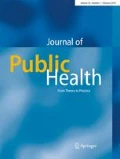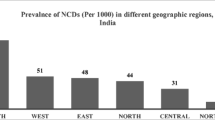Abstract
Aim
This study examines the current scenario of the self-reported prevalence of non-communicable diseases (NCDs) in India and states, with a gender perspective. It also explores different factors affecting the prevalence of NCDs among men and women.
Subjects and methods
The study has used data from recent NSSO (71st Round, 2014) survey. Simple bivariate analyses are used to calculate the prevalence rate of NCDs per thousand persons. Binary logistics regression is applied to examine the effects of demographic and socioeconomic variables on the prevalence of NCDs.
Results
The overall prevalence of NCDs is 55 per thousand persons. The prevalence is higher among women (63) as compared to men (47). Among Indian states, difference in the prevalence of NCDs between men and women is the highest in Punjab (45), followed by Himachal Pradesh (44) and Uttaranchal (37), whereas among the union territories (UTs), Daman and Diu (230) shows the widest gap in the prevalence of NCDs between men and women. Rural women (86) are found at the higher risk of NCDs as compared to rural men (64) and their counterpart in urban areas (53). The NCD prevalence is significantly higher among the population aged above 60 years (OR = 8.30, p < 0.001) and in richer section (OR = 1.21, p < 0.001).
Conclusions
In India, women are disproportionately affected by NCDs as compared to men. Across the region, a large gap exists in NCD prevalence between men and women. Hence, there is an urgent need to address this issue in high NCD prevalent states, particularly focusing women from socio-economically disadvantaged background.


Similar content being viewed by others
References
Acton KJ, Ríos Burrows N, Moore K, Querec L, Geiss LS, Engelgau MM (2002) Trends in diabetes prevalence among American Indian and Alaska Native children, adolescents, and young adults. Am J Public Health 92:1485–1490. doi:10.2105/AJPH.92.9.1485
Alliance NCD (2011) Communicable diseases: a priority for women’s health and. 1–20.
Alves L, Rodrigues R (2005) Determinants of self-rated health among elderly persons in São Paulo, Brazil. PubMed Commons 17:6–7
Anchala R, Kannuri NK, Pant H, Khan H, Franco OH, Angelantonio ED, Prabhakaran D (2014) Hypertension in India. J Hypertens 32:1170–1177. doi:10.1097/HJH.0000000000000146
Anish TS, Shahulhameed S, Vijayakumar K, Joy TM, Shreelakshmi PR, Kuriakose A (2013) Gender difference in blood pressure, blood sugar, and cholesterol in young adults with comparable routine physical exertion. J Family Med Prim Care 2:200–203. doi:10.4103/2249-4863.117424
Baruah MP, Pathak A, Kalra S, Das AK, Zargar AH, Bajaj S, Unnikrishnan AG, Sahay RK (2014) A revisit to prevailing care and challenges of managing diabetes in India: focus on regional disparities. Indian J Endocrinol Metab 18:254–263. doi:10.4103/2230-8210.131113
Bora JK, Saikia N (2015) Gender differentials in self-rated health and self-reported disability among adults in India. PLoS ONE 10(11), e0141953. doi:10.1371/journal.pone.0141953
Beaglehole R, Bonita R, Horton R, Adams C, Alleyne G, Asaria P, Baugh V, Bekedam H, Billo N, Casswell S, Cecchini M, Colagiuri R, Colagiuri S, Collins T, Ebrahim S, Engelgau M, Galea G, Gaziano T, Geneau R, Haines A, Hospedales J, Jha P, Keeling A, Leeder S, Lincoln P, McKee M, MacKay J, Magnusson R, Moodie R, Mwatsama M, Nishtar S, Norrving B, Patterson D, Piot P, Ralston J, Rani M, Reddy KS, Sassi F, Sheron N, Stuckler D, Suh I, Torode J, Varghese C, Watt J (2011) Priority actions for the non-communicable disease crisis. Lancet 377:1438–1447. doi:10.1016/S0140-6736(11)60393-0
Bhagyalaxmi A, Atul T, Shikha J (2013) Prevalence of risk factors of non-communicable diseases in a district of Gujarat, India. J Health Popul Nutr 31:78–85
Bonita R, Beaglehole R (2014) Women, and NCDs: overcoming the neglect. Glob Health Action 7:23742. doi:10.3402/gha.v7.23742
Campos ACV, Albala C, Lera L, Sánchez H, Vargas AMDV, Ferreira EF (2015) Gender differences in predictors of self-rated health among older adults in Brazil and Chile. BMC Public Health 15:365. doi:10.1186/s12889-015-1666-9
Case A, Paxson C (2005) Sex differences in morbidity and mortality. Demography 42(2):189–214
Crimmins EM, Kim JK, Solé-Auró A (2011) Gender differences in health: results from SHARE, ELSA and HRS. Eur J Pub Health 21:81–91. doi:10.1093/eurpub/ckq022
Crocetti E, De Angelis R, Buzzoni C, Mariotto A, Storm H, Colonna M, Zanetti R, Serraino D, Michiara M, Cirilli C, Iannelli A, Mazzoleni G, Sechi O, Gonzalez MES, Guzzinati S, Capocaccia R, Maso LD, AIRTUM Working group (2013) Cancer prevalence in United States, Nordic countries, Italy, Australia, and France: an analysis of geographic variability. Br J Cancer 109:219–228. doi:10.1038/bjc.2013.311
Gupta R, Guptha S, Sharma KK, Gupta A, Deedwania P (2012) Regional variations in cardiovascular risk factors in India: India heart watch. World J Cardiol 4:112–120. doi:10.4330/wjc.v4.i4.112
Hassanzadeh J, Moradi N, Esmailnasab N, Rezaeian S, Bagheri P, Armanmehr V (2014) The correlation between gender inequalities and their health related factors in world countries: a global cross-sectional study. Epidemiol Res Int 2014:521569. doi:10.1155/2014/521569, 8 pp
Hawkes C, Popkin BM (2015) Can the sustainable development goals reduce the burden of nutrition-related non-communicable diseases without truly addressing major food system reforms? BMC Med 13:143. doi:10.1186/s12916-015-0383-7
Hosseinpoor AR, Stewart Williams J, Amin A, Araujo de Carvalho I, Beard J, Boerma T, Kowal P, Naidoo N, Chatterji S (2012) Social determinants of self-reported health in women and men: understanding the role of gender in population health. PLoS ONE 7:1–16. doi:10.1371/journal.pone.0034799
Khuwaja AK, Kadir MM (2010) Gender differences and clustering pattern of behavioural risk factors for chronic non-communicable diseases: community-based study from a developing country. Chronic Illn 6:163–170
McDonough P, Walters V (2001) Gender and health: Reassessing patterns and explanations. Soc Sci Med 52 (4):547–559. doi:10.1016/S0277-9536(00)00159-3
Mendoza-Sassi RA, Béria JU (2007) Gender differences in self-reported morbidity: evidence from a population-based study in southern Brazil. Cad. Cad Saude Publica 23(2):341–346
Miszkurka M, Haddad S, Langlois ÉV, Freeman EE, Kouanda S, Zunzunegul MV (2012) Heavy burden of non-communicable diseases at early age and gender disparities in an adult population of Burkina Faso: world health survey. BMC Public Health 12:24. doi:10.1186/1471-2458-12-24
Mohan V, Mathur P, Deepa R, Deepa M, Shukla DK, Menon GR, Anand K, Desai NG, Joshi PP, Mahanta J, Thankappan KR, Shah B (2008) Urban rural differences in prevalence of self-reported diabetes in India: the WHO-ICMR Indian NCD risk factor surveillance. Diabetes Res Clin Pract 80:159–168. doi:10.1016/j.diabres.2007.11.018
Muggah E, Graves E, Bennett C, Manuel DG (2013) Ascertainment of chronic diseases using population health data: a comparison of health administrative data and patient self-report. BMC Public Health 13:16. doi:10.1186/1471-2458-13-16
Maina WK (2011) Integrated non-communicable disease prevention into maternal and child health programs: can it be done and what will it take. Int J Gynaecol Obstet 115:S34–S36
National Sample Survey Organisation (2014) Social consumption in India, Health (NSSO 71st round, January–June 2014). New Delhi: National Sample Survey Organisation, Ministry of Statistics and Programme Implementation, Government of India, New Delhi
Pan American Health Organization (2011) Series: chronic disease issue Brief 2: chronic diseases on global agendas. PAHO, Washington, DC
Patra S, Arokiasamy P, Goli S (2014) Relevance of health knowledge in reporting maternal health complications and use of maternal health care in India. Health Care Women Int 1–19. doi:10.1080/07399332.2014.946509
Raj A (2011) Gender equity and universal health coverage in India. Lancet 377:618–619. doi:10.1016/S0140-6736(10)62112-5
Shakya A, Mishra SR, Giri S, Paudel K, Neupane D (2014) Gender differences and clustering of modifiable risk factors of non-communicable diseases among medical students: a cross sectional study in Nepal. J Community Health 40:147–152. doi:10.1007/s10900-014-9912-0
Sharma K (2013) Burden of non communicable diseases in India: setting priority for action. Int J Med Sci Public Heal 2:7. doi:10.5455/ijmsph.2013.2.7-11
Sen G, Östlin P (2007) Unequal, unfair, ineffective and inefficient gender inequity in health: why it exists and how we can change it. Final report submitted to the WHO Commission on Social Determinants of Health, Women and Gender Equity Knowledge Network, WHO, Geneva, 145 pp
Sengupta M, Agree E (2002) Gender and disability among older adults in North and South India: differences associated with coresidence and marriage. J Cross Cult Gerontol 17:313–336. doi:10.1023/A:1023079219538
Silva ER, Ivankovich M, Jose R, Faramand T (2014) Addressing the unique needs of men and women in non-communicable disease services. USAID Assist Project, USAID, Bethesda, MD
Simpson CR, Sheikh A (2010) Trends in the epidemiology of asthma in England: a national study of 333,294 patients. J R Soc Med 103:98–106. doi:10.1258/jrsm.2009.090348
Teh JKL, Tey NP, Ng ST (2014) Ethnic and gender differentials in non-communicable diseases and self-rated health in Malaysia. PLoS ONE 9, e91328. doi:10.1371/journal.pone.0091328
Upadhyay RP (2012) An overview of the burden of non-communicable diseases in India. Iran J Public Health 41:1–8
Vadrevu L, Kumar V, Kanjilal B, Professor A (2015) Gender differentials in the impact of multi-morbidity on self-rated health in rural West Bengal in India. IOSR J Nurs Health Sci 4:2320–1940. doi:10.9790/1959-04231621
Van Minh H, Ng N, Juvekar S, Razzaque A, Ashraf A, Hadi A, Soonthornthada K, Bich TH, Kanungsukkasem U, Byass P (2008) Self-reported prevalence of chronic diseases and their relation to selected sociodemographic variables: a study in INDEPTH Asian sites, 2005. Prev Chronic Dis 5:A86
Vellakkal S, Subramanian SV, Millett C, Basu S, Stuckler D, Ebrahim S (2013) Socioeconomic inequalities in non-communicable diseases prevalence in India: disparities between self-reported diagnoses and standardized measures. doi:10.1371/journal.pone.0068219
Vlassoff C (2007) Gender differences in determinants and consequences of health and illness. J Heal Popul Nutr 25:47–61
Wandera SO, Kwagala B, Ntozi J (2015) Prevalence and risk factors for self-reported non-communicable diseases among older Ugandans: a cross-sectional study. Glob Health Action 8:1–10. doi:10.3402/gha.v8.27923
World Health Organization (2008) The global burden of disease: 2004 update. Update 2010:146. WHO, Geneva. doi:10.1038/npp.2011.85
World Health Organization (2010) Global status report on noncommunicable diseases. WHO, Geneva
World Health Organization (2015) International classification of diseases, 10th revision. WHO, Geneva
Author information
Authors and Affiliations
Corresponding author
Ethics declarations
The data used for this study considered all the ethical issues while collecting information and it is available to all users upon request. This paper is not published previously and not submitted elsewhere.
Funding
The study is not funded by any funding agency.
Conflict of interest
The authors declare that there is no conflict of interest.
Electronic supplementary material
Below is the link to the electronic supplementary material.
ESM 1
(JPG 392 kb)
Rights and permissions
About this article
Cite this article
Patra, S., Bhise, M.D. Gender differentials in prevalence of self-reported non-communicable diseases (NCDs) in India: evidence from recent NSSO survey. J Public Health 24, 375–385 (2016). https://doi.org/10.1007/s10389-016-0732-9
Received:
Accepted:
Published:
Issue Date:
DOI: https://doi.org/10.1007/s10389-016-0732-9




